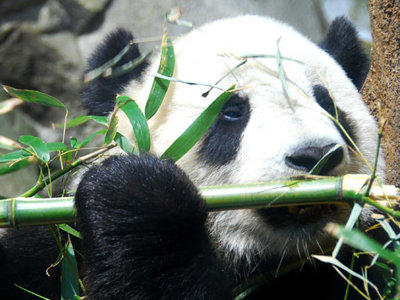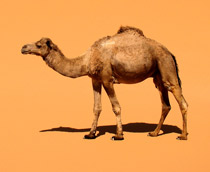

Mammals - Asian Mammals
Asia represents almost one-third of earth's land mass. Its holds the world's highest point, Mt. Everest, and the lowest point outside of uninhabitable Antarctica, the Dead Sea. It is home to both the largest and deepest lakes on Earth, the Caspian Sea and Lake Baikal. Out of the twelve longest rivers on Earth, seven wind through Asia. All the world's major religions originated in Asia, and two out of every three people on Earth live there.
The countries of Asia are so diverse that on the surface they have little in common. If anything, their commonality lies in diversity itself. And of course, Asia's wildlife is incredibly rich and varied. Test your knowledge in the following Picture Quiz about the mammals of Asia. Don't forget to click on the photos to get a larger image. Good luck!
- Order: Artiodactyla
- Family: Bovidae
- Genus: Budorcas
- Species: B. taxicolor
- Also known as gnu goat or cattle chamois.
- Mitochondrial research shows that takin are related to sheep.
- Biologist George Schaller likened the takin to a 'bee-stung moose', because of the swollen appearance of the face.
- Order: Artiodactyla
- Family: Camelidae
- Genus: Camelus
- Species: C. dromedarius
- Also known as the Arabian camel.
- Only has one hump on its back.
- Dromedaries have distinctive features of thick eyelashes and small, hairy ears.
- They kneel for loading cargo and passengers.
- Order: Carnivora
- Family: Ursidae
- Genus: Ailuropoda
- Species: A. melanoleuca
- The giant panda is among the world's most adored and protected rare animals.
- Pandas do not hibernate, but rather move to elevations with warmer temperatures.
- The World Wide Fund for Nature (WWF) uses a panda as its symbol.
- Order: Rodentia
- Family: Sciuridae
- Genus: Ratufa
- Species: R. indica
- This squirrel dwells in the upper canopies of trees and is able to jump up to 6 m (20 ft) between trees.
- They tend to live alone or in pairs.
- It can build several nests close to each other which are used as sleeping quarters.
- A sanctuary to protect the habitat of this animal was created in 1984 in India.
- Order: Primates
- Family: Cercopithecidae
- Genus: Macaca
- Species: M. fuscata
- It lives in areas where snow covers the ground for months each year.
- No primate, with the exception of humans, is more northern-living, nor lives in a colder climate.
- Have been observed rolling snowballs for fun.
- Order: Proboscidea
- Family: Elephantidae
- Genus: Elephas
- Species: E. maximus
- Is listed by the International Union for Conservation of Nature (IUCN) as endangered.
- It is extensively domesticated, and has been used in forestry in South and Southeast Asia for centuries.
- Order: Carnivora
- Family: Felidae
- Genus: Uncia
- Species: uncia
- It lives in mountainous regions.
- Baby snow leopards have full black spots when they are born which turn into rosettes as they mature.
- Ambushes prey from above and is able to leap as far as 14 metres (46 ft).
- Order: Carnivora
- Family: Felidae
- Genus: Panthera
- Species: P. tigris
- The Bengal tiger is the national animal of Bangladesh and India.
- In a poll conducted by Animal Planet, the tiger was voted the world's favourite animal, narrowly beating the dog. More than 50,000 viewers from 73 countries voted in the poll.
- Order: Artiodactyla
- Family: Bovidae
- Genus: Oryx
- Species: O. leucoryx
- Native to desert and steepe areas of the Arabian peninsula.
- The legend of the Unicorn may have originated in part from this animal which can appear to have only one horn when seen in profile.
- Order: Primates
- Family: Lorisidae
- Genus: Loris
- A small, nocturnal primate which lives in Southern India and Sri Lanka.
- It moves carefully and slowly along the treetops of the tropical rainforests.
- Will eat noxious and bad smelling insects.
- They are partial to the acacia ant whose bite can numb a human arm.
Ready for more?
not all...
quizzers. Try to win a coveted spot on our Hall of Fame Page.
















